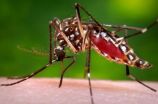(Press-News.org) A handful of genes arm the woodrat against the toxic chemicals in its foodstuff, the creosote plant, according to research published in the open access journal BMC Ecology.
It's long been a mystery exactly how the woodrat developed the ability to handle the chemicals in the creosote plant, which are toxic to other rodents. Previous research has suggested that they are protected by factors such as gut bacteria. But the new study identifies the genes switched on in two species of woodrat with resistance to the plant poisons, showing that the genes that they are born with play a central role in whether they feel the effects of its toxic chemicals.
Creosote bushes and the woodrat have been in an evolutionary arms race, ever since the bush started colonizing the deserts of the western USA, where the rat lives. To save itself from being eaten, the plant's leaves are covered with a toxic resin containing the chemical nordihydroguaiaretic acid (NDGA). Most rodents' livers and kidneys are ravaged by the substance, but woodrats detoxify the substance so they can eat creosote plants as a normal part of their diet. Being able to withstand the creosote bush's resin gives them exclusive access to the valuable food source in an area with little plant life.
Two closely related species of woodrat have switched over from juniper and cactus to creosote at different times - the Neotoma bryanti woodrat was first in contact with creosote bush 7,000 years before the Neotoma lepida woodrat.
Scientists from University of Utah and Weber State University have investigated the gene expression in N. bryanti and N. lepida to see what enzymes the species produced in reaction to the plant resin. They looked at three groups – 'experienced' N.bryanti and N.lepida that had been exposed to creosote in the wild, and 'naive' N.bryanti, a population of woodrats for whom creosote was a new addition to their diet.
They found that when woodrats had been exposed to the creosote bush in the wild, a small number of similar genes were switched on by both species to detoxify the plant, despite having evolved the mechanisms at completely different times.
Jael Malenke from the University of Utah says: "We were surprised by how few genes were induced by woodrats of both species when they were consuming a toxin-laced diet. We expected a huge list of genes - instead we found very few."
When the creosote was a new addition to the diet of individual N.bryanti woodrats, they had different reactions. They exhibited signs of severe stress, showing that because they hadn't been exposed to the diet, the genes to detoxify it hadn't been switched on.
Dr Malenke says: "For N. bryanti but not for N. lepida, there appears to be a hidden strategy of maintaining expression of exactly the right combination of enzymes to suit the animal's 'normal' diet and not altering that expression, even with a change in diet. Although very efficient, this strategy might be a disadvantage, say, in the face of a climate change event".
INFORMATION:
Notes
Research Article
Evidence for functional convergence in genes upregulated by herbivores ingesting plant secondary compounds
Jael R Malenke, Michele M Skopec and M Denise Dearing
BMC Ecology 2014, 14:23
For a copy of the article, please contact anna.perman@biomedcentral.com
After embargo, article available at journal website here:
http://www.biomedcentral.com/1472-6785/14/23
Please name the journal in any story you write. If you are writing for the web, please link to the article. All articles are available free of charge, according to BioMed Central's open access policy.
BMC Ecology is an open access, peer-reviewed journal that considers articles on environmental, behavioral and population ecology as well as biodiversity of plants, animals and microbes.
BioMed Central is an STM (Science, Technology and Medicine) publisher which has pioneered the open access publishing model. All peer-reviewed research articles published by BioMed Central are made immediately and freely accessible online, and are licensed to allow redistribution and reuse. BioMed Central is part of Springer Science+Business Media, a leading global publisher in the STM sector.
Woodrats' genes help them to win the arms race against their food
2014-08-15
ELSE PRESS RELEASES FROM THIS DATE:
Experimental chikungunya vaccine induces robust antibody response
2014-08-15
An experimental vaccine to prevent the mosquito-borne viral illness chikungunya elicited neutralizing antibodies in all 25 adult volunteers who participated in a recent early-stage clinical trial conducted by researchers at the National Institute of Allergy and Infectious Diseases (NIAID), part of the National Institutes of Health. The results are reported in the current issue of The Lancet.
The most distinctive symptom of chikungunya infection is severe joint pain accompanied by headache and fever. There are currently no vaccines or specific drug treatments for chikungunya. ...
The Lancet: European Society of Cardiology Congress media alert
2014-08-15
The Lancet is pleased to announce that the following papers will be published ahead of the European Society of Cardiology Congress 2014, taking place in Barcelona, Spain, from 30 August to 3 September 2014. This includes a special Series of three papers on lipids and cardiovascular disease.
Blood pressure-lowering treatment based on cardiovascular risk: a meta-analysis of individual patient data by Dr Johan Sundström et al
This study investigated whether the success of blood pressure-lowering drugs is dependent on baseline cardiovascular risk, and whether this could ...
The Lancet: virus-like particle vaccine shows promise against chikungunya
2014-08-15
The first human trial of a new vaccine developed using non-infectious virus-like particles (VLP) appears likely to offer protection against chikungunya virus, a mosquito-borne infection, according to a study published in The Lancet. Since its re-emergence in 2004, chikungunya virus has become a growing public-health threat that has affected millions of people in Africa, Asia, and Europe, and in recent months it has been spreading throughout the Americas.
"Chikungunya virus has adapted itself to be transmitted by not only the Aedes aegypti mosquito that lives mainly in ...
Gender disparities uncovered in desire to receive living donor kidney transplants
2014-08-15
Washington, DC (August 14, 2014) — Among black kidney failure patients undergoing dialysis, women are much less likely than men to want to receive kidney transplants from living donors, despite more offers from family and friends. The findings, which are from a study appearing in an upcoming issue of the Clinical Journal of the American Society of Nephrology (CJASN), suggest that interventions are needed to increase women's acceptance of living donor kidney transplantation.
Living donor kidney transplantation is the treatment of choice for patients with kidney failure, ...
Make your mobile device live up to its true potential -- as a data collection tool
2014-08-15
Leaf measurements are often critical in plant physiological and ecological studies, but traditional methods have been time consuming and sometimes destructive to plant samples. Researchers at the University of California, Davis, have developed Easy Leaf Area—a free software written in an open-source programming language—to allow users to accurately measure leaf area from digital images in seconds.
"It has always been a challenge to measure leaf surface area without damaging the plants or spending long hours in the lab, so I decided to attempt to write software to automatically ...
Low education, smoking, high blood pressure may lead to increased stroke risk
2014-08-14
Adults smokers with limited education face a greater risk of stroke than those with a higher education, according to new research in the American Heart Association's journal Stroke.
The combination of smoking and high blood pressure increased stroke risk the most, confirming earlier findings in numerous studies.
In a multicenter Danish study, researchers defined lower education as grade school or lower secondary school (maximum of 10 years) education.
"We found it is worse being a current smoker with lower education than a current smoker with a higher education," said ...
Mass layoffs linked to increased teen suicide attempts
2014-08-14
DURHAM, N.C. -- Mass layoffs may trigger increased suicide attempts and other suicide-related behaviors among some teenagers, says new research from Duke University.
Lead author Anna Gassman-Pines found that when 1 percent of a state's working population lost jobs, suicide-related behaviors increased by 2 to 3 percentage points among girls and black adolescents in the following year. Among girls, thoughts of suicide and suicide plans rose. Among black teens, thoughts of suicide, suicide plans and suicide attempts all increased.
"Job loss can be an unanticipated shock ...
Prevalence, risk factors for diabetic macular edema explored in study
2014-08-14
Bottom Line: The odds of having diabetic macular edema (DME), a leading cause of vision loss in patients with diabetes mellitus, appears to be higher in non-Hispanic black patients than white patients, as well as in those individuals who have had diabetes longer and have higher levels of hemoglobin A1c.
Author: Rohit Varma, M.D., M.P.H., of the University of Southern California, Los Angeles, and colleagues.
Background: About 347 million people worldwide have diabetes and diabetic eye disease is a leading cause of vision loss in patients between the ages of 20 and 74 ...
Strong state alcohol policies reduce likelihood of binge drinking
2014-08-14
(Boston) – People living in states with stronger alcohol policy environments have a substantially lower likelihood of any binge drinking, frequent binge drinking, and high-intensity binge drinking, according to a new study by researchers at the Boston University School of Public Health (BUSPH) and Boston Medical Center (BMC), published in the current issue of the American Journal of Public Health.
Specifically, the study found, each 10 percentage point increase in the strength of a state's alcohol policy score (reflecting more effective and/or better implemented alcohol ...
New tool makes a single picture worth far more than a thousand words
2014-08-14
A photo is worth a thousand words, but what if it could also represent a hundred thousand other images?
New software developed by UC Berkeley computer scientists seeks to tame the vast amount of visual data in the world by generating a single photo that can represent massive clusters of images. This tool can give users the photographic gist of a kid on Santa's lap, housecats, or brides and grooms at their weddings. It works by generating an image that literally averages the key features of the other photos.
Users can also give extra weight to specific features to ...


